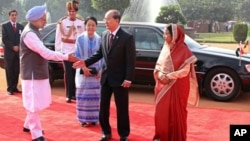India is welcoming Burma's transition to democracy during a visit to New Delhi by Burma's president.
During Friday's talks in New Delhi, Burmese President Thein Sein and Indian Prime Minister Manmohan Singh agreed to increase cooperation in oil and gas exploration.
The Burmese leader said he would encourage more Indian investment in his country's energy sector, and Prime Minister Singh offered Burma a $500 million line of credit for infrastructure projects.
Border ties
With a 1,600 kilometer-long border with Burma, India has been forging close ties with its eastern neighbor for over a decade. On Friday, the Indian and Burmese leaders said they will take their friendship to a new level.
India’s foreign ministry spokesman, Vishnu Prakash, underscored Burma's, or Myanmar's, strategic importance for India as a bridge to Southeast Asia and the members of the Association of Southeast Asian Nations, or ASEAN.
“Myanmar is the only Southeast Asian state with which we have a land boundary and as such it is a bridge between South Asia and Southeast Asia and a gateway to the ASEAN region," Prakash said.
The Burmese military handed power in March to an elected civilian government. But critics say the new government is dominated by retired army officials.
In recent months, Burmese President Thein Sein has made several overtures toward the opposition, including freeing 200 political prisoners, loosening some controls on the media and starting a dialogue with opposition leader Aung San Suu Kyi.
Prime Minister Singh has welcomed these efforts and offered to share India's experience with parliamentary democracy in order to help Burma with its democratic transition.
The Burmese leader's visit to India comes two days after Vietnam's president traveled to New Delhi for talks with Indian leaders.
India and Vietnam signed a security pact and India sealed an accord to promote oil exploration with Vietnam in the South China Sea, ignoring Chinese objections to the project.
India's 'Look East' strategy
The back-to-back visits by the heads of two Southeast Asian countries are being seen as the success of India’s so-called “Look East” policy of developing closer ties with a resource-rich, economically vibrant region.
India foreign ministry spokesman Vishnu Prakash says deepening trade and diplomatic links with the 10 members of ASEAN is a priority.
“We have great affinities, linguistic cultural, ethnic, with the ASEAN region which we consider to be part of our extended neighborhood, and with many of the countries we have maritime boundaries," Prakash said. "So it is very natural for us to engage closely with our ASEAN neighbors and friends.”
Some analysts in New Delhi say that East Asian countries are also seeking closer links to India, both to gain from its growing economy and because it presents a counterbalance to China.









